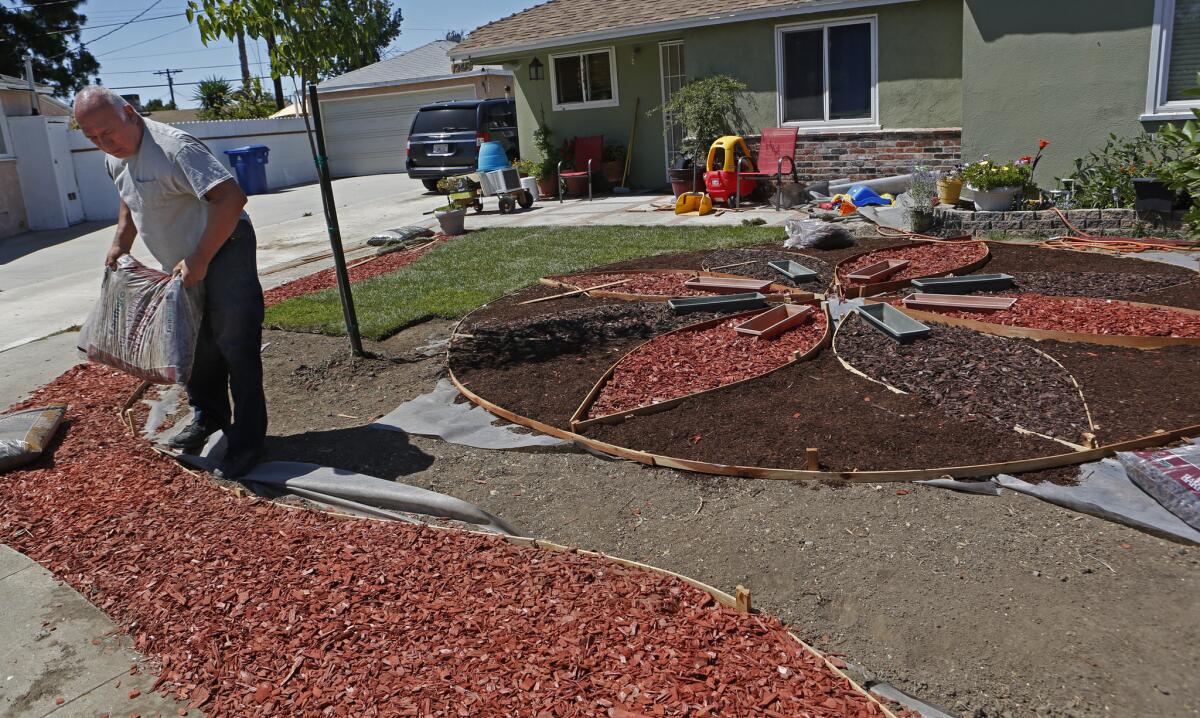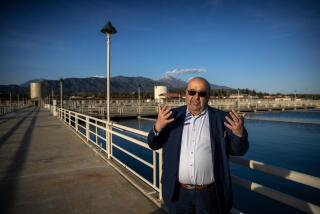Not much bang for the buck in DWP turf rebates, city controller audit says

Richard Delgado, 65, replaces most of the turf in his frontyard with three different colors of bark in the San Fernando Valley in June.
Los Angelesâ turf rebate program saved less water per dollar spent than other Department of Water and Power conservation programs, an audit released by the city controller said Friday.
Auditors found that money spent for rebates on items such as high-efficiency appliances yielded a water savings almost five times higher than turf replacement. They also found that the DWP does not prioritize water conservation projects based on which are the most cost-effective.
City Controller Ron Galperin called on the water provider to focus its conservation programs in order to achieve more sustained and cost-effective water savings.
âIf money is no object, turf replacement rebates are a relatively expedient way to save water,â Galperin said. âBut, of course, money is an object.â
In fiscal year 2014-15, the DWP spent $40.2 million on customer incentive and rebate programs, Galperinâs office said. Nearly $17.8 million of that went to turf rebates. Each dollar invested in turf rebates is expected to save 350 gallons of water over the estimated 10-year âlife expectancyâ of residential turf replacement, the audit said.
In comparison, the department spent $14.9 million on rebates for high-efficiency appliances and fixtures. Those rebates yield a per-dollar savings of more than 1,700 gallons of water over their estimated lifetimes of up to 19 years, Galperinâs office said.
The turf rebate program âhad value as a gimmick that ⌠probably spurred a heightened awareness,â Galperin said at a news conference, adding: âItâs the job of my office to look at return on investment.â
In a statement, DWP Board President Mel Levine and General Manager Marcie Edwards said the agency wants to offer âa menu of toolsâ to customers. However, they added, appliance rebates, which have been around since the early 1990s, are not in as high demand as they once were.
âFor many of these fixtures we have reached a market saturation point and they no longer offer the broad-based water savings opportunities they once did,â Levine and Edwards said. âLADWPâs turf replacement program has helped us target the largest remaining opportunity for broad-based water savings: outdoor water use.â
Mayor Eric Garcetti said the turf replacement program had more long-term goals than just upfront water savings.
âOur cityâs water conservation efforts arenât just about reacting to the current crisis, but rather changing the way we think about water,â Garcetti said in a statement.
The DWP has allocated $59 million for water conservation programs this year, Galperinâs office said. He called on the agency to base its rebates on water saved, and advocated for the widespread installation of so-called smart meters, which give customers real-time information about their water usage.
He also said the department should invest more in water infrastructure and technology, such as water recycling and storm-water capture.
âWater conservation programs should be assessed based on how much water they save, and whether they will enhance our future supplies,â Galperin said in a statement.
But experts said the audit overlooked some major benefits of the turf replacement rebate programs.
J.R. DeShazo, director of the Luskin Center for Innovation at UCLA and professor of public policy and urban planning, said the audit did not seem to take into account the high price of water as well as the relatively small amount of water saved by a high-efficiency appliance compared with drought-tolerant landscaping.
âThese investments are freeing up water at a lower cost than the DWP could buy the same amount of water from MWD [Metropolitan Water District of Southern California], and we can get a lot of water out of the turf rebate program,â DeShazo said.
Though DeShazo agreed that smart meters are worth consideration, the devices and their installation are very expensive â much more expensive than the turf rebate program â and also serve as an educational tool that does not directly affect consumption.
By some accounts, Californiansâ penchant for ripping out their grass has been the most significant silver lining of the stateâs ongoing drought.
In October 2014, Garcetti ordered an increase in the size of turf removal rebates to as much as $3.75 per square foot. In those large payouts, the MWD paid $2, and the DWP paid $1.75.
Then on April 1, Gov. Jerry Brown issued a historic executive order calling on Californians to reduce their urban water consumption by 25%. As a part of that order, he called on the state to replace 50 million square feet of lawns with drought-tolerant landscaping in partnership with local governments.
Weeks later, Garcetti said Los Angeles alone would account for half of Brownâs goal by the end of 2015.
By July, the MWD said it had stopped offering rebates, having committed more than $300 million to customers for lawn removal. The DWP continues to offer the rebates without the MWDâs contribution.
The DWP has thus far refused to release the names and addresses of residents who received turf rebates, citing privacy concerns.
Galperin called for the DWP to release them. The agency is suing the MWD to keep the information private.
âBilling information for customers ⌠is different than the person who voluntarily chooses to ask for an incentive or rebate and gets money from ratepayers for that,â Galperin said.
Times staff writer David Zahniser contributed to this report.
Twitter: @bymattstevens @taygoldenstein
ALSO
Teen charged with murder in Downey police officerâs slaying
A black woman âbroke inâ to her own home. Hereâs a breakdown of the police audio
Massive El NiĂąo gains strength, likely to drench key California drought zone
More to Read
Sign up for Essential California
The most important California stories and recommendations in your inbox every morning.
You may occasionally receive promotional content from the Los Angeles Times.












